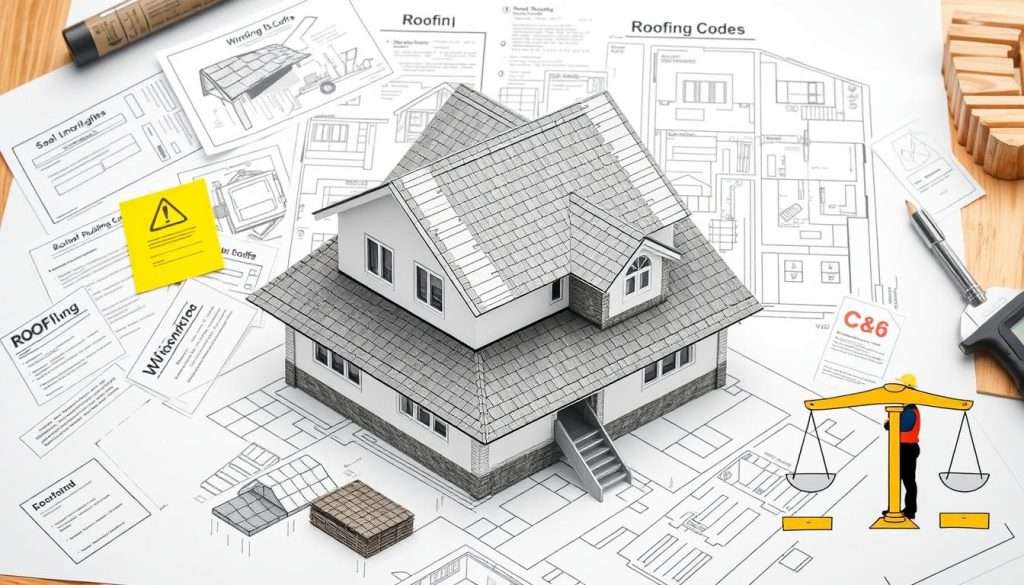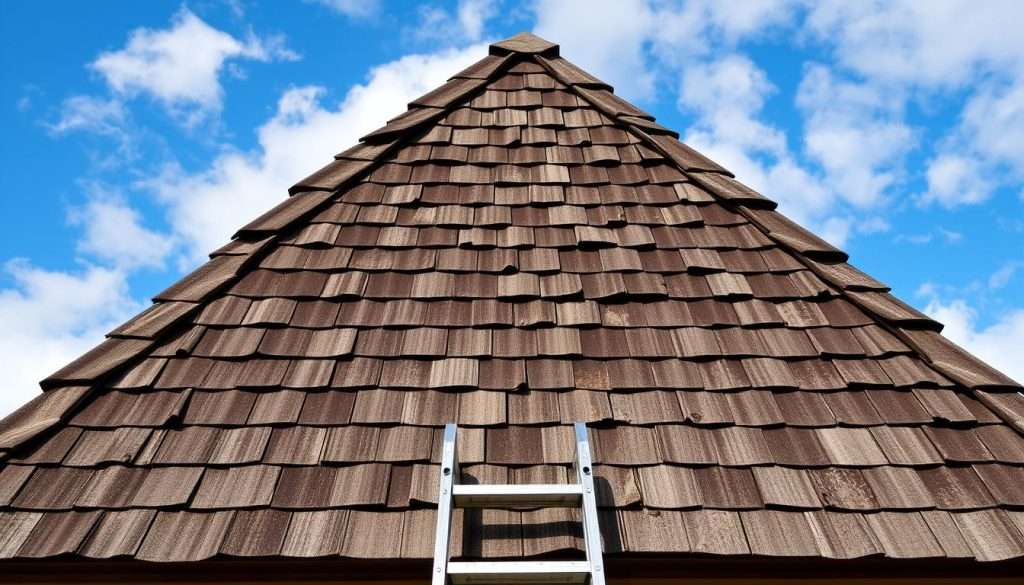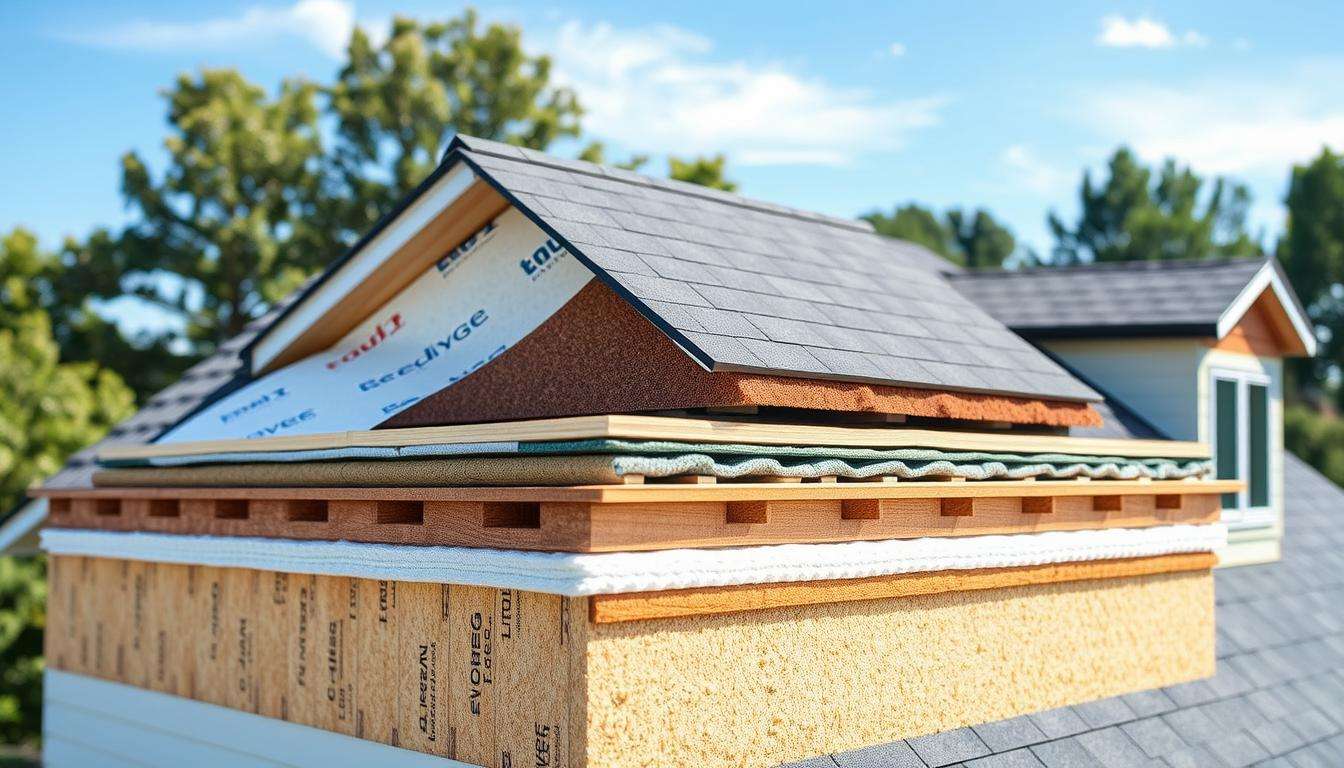Knowing how many layers your roof has is key for keeping it in good shape. Roofs have many parts, each doing its own job to protect your home. By checking these layers, you can keep your roof strong.
A typical roof has several layers:
- Roof deck or sheathing
- Underlayment or roofing felt
- Roof insulation
- Ice and water shield
- Outer materials (like asphalt shingles)
- Flashing
- Roof ventilation components
- Gutters and downspouts
It’s important to check your roof often. This guide will show you how to check your roof. It will also talk about the benefits of having many layers and where to find help.
Understanding Roof Layers: An Overview
Roofing systems have many layers that work together. They protect your home from rain, snow, and sun. Each layer has its own job, making the roof strong and effective.
What Are Roof Layers?
Roofing systems have several key layers. The roof deck is made of plywood or OSB. It gives the roof its shape.
On top of the deck, a water barrier stops moisture. This layer keeps your home dry.
- Framing: This foundational part includes trusses, supporting the weight of all subsequent layers.
- Insulation: Placed mainly in the attic, this layer minimizes heat loss and protects the layers of roofing materials from extreme temperatures.
- Ventilation: Essential for preventing mold growth, ventilation allows moist air to escape and keeps the roof in good health.
- Underlayment: This layer, made from felt or synthetic materials, serves as an additional protective barrier.
- Shingles: Acting as the outermost layer, shingles shield against weather and UV exposure.
Common Roofing Materials
Knowing about roofing materials helps homeowners choose wisely. Here are some common ones:
| Material Type | Durability | Cost |
|---|---|---|
| Asphalt Shingles | Good | Low |
| Metal Panels | Excellent | Medium |
| Clay Tiles | Very Good | High |
| Slate | Exceptional | Very High |
Importance of Layer Count
The number of layers in your roof matters a lot. More layers mean better insulation and protection. But, too many can cause structural problems.
Following local building codes is important. It ensures your roof is safe and works well.
How to Determine the Number of Roof Layers
Knowing how many layers your roof has is key for keeping it safe and in good shape. There are several ways to figure this out. We’ll look at some top methods to help you count your roof’s layers.
Visual Inspection Techniques
First, look at your roof with your eyes. Check the edges or any spots that are damaged. Look at the shingles and any patches to see if they show multiple layers. Here are some things to look for:
- Exposed corners or edges of the roof
- Uneven or buckled shingles
- Signs of severe weather damage
Using a Roof Probe
A roof probe is a great tool to check layers without harming your roof. It lets you gently push under the shingles. This way, you can see:
- The individual layers of roofing material
- The condition of each layer
- Potential weaknesses or vulnerabilities
Hiring a Professional Inspector
If you’re not sure about inspecting your roof, get a pro to do it. They have the skills and tools to check your roof layers right. A pro can tell you about:
- Identifying hidden structural issues
- Determining roof layer count efficiently
- Recommending appropriate maintenance or repairs
Using these methods to inspect your roof keeps it safe and working well. Knowing how many layers you have helps prevent problems. Too many layers can make your roof weak and unsafe.
Implications of Multiple Roof Layers
Knowing about multiple roofing layers is key to keeping your home safe. Each layer brings its own set of problems. These issues can affect how well your roof works and how long it lasts.
Weight Considerations
Roof weight is a big deal. Each layer adds weight, which can be too much. In places like Portland, you can only have two layers.
Having more than two can stress your roof’s structure. This can make your roof unsafe. It’s important to know how much weight your roof can handle.
Increased Risk of Damage
More layers mean more chance of roof damage. Moisture gets trapped, leading to leaks and mold. This can cause water damage.
Bad ventilation also means your insulation doesn’t work well. This can make your energy bills go up. The top layer might hide problems, making repairs harder and more expensive.
Impact on Roof Lifespan
Adding layers might seem good, but it can actually shorten your roof’s life. The extra weight and heat make your roof wear out faster. You might need to fix it more often.
Spot repairs can lead to bigger, more expensive problems later. It’s important to check your roof often to keep it safe and working well.
| Consideration | Implication |
|---|---|
| Weight of Additional Layers | Increases structural stress; may exceed building code limits |
| Moisture Trapping | Higher risk of leaks and mold growth; reduces ventilation |
| Increased Repair Costs | Hidden damage complicates repairs; spot fixes become common |
| Energy Efficiency | Poor ventilation leads to higher heating/cooling costs |
| Overall Roof Lifespan | Accelerated wear and tear due to trapped heat; necessitates earlier replacements |
Local Building Codes and Regulations
Knowing local building codes is key for homeowners. These rules help keep homes safe and strong. They tell us how many layers of roof are okay and when more work is needed.
Guidelines on Roof Layering
Most places say you can’t have more than two layers of shingles. This rule stops roofs from getting too heavy. In California, for instance, you can only have two layers of shingles.
Roofers often have to take off old shingles before putting on new ones. This makes the job safer.
When to Remove Existing Layers
It’s time to remove old layers if your roof has two or if it’s not strong enough. Adding more layers can cause leaks and mold. Heavy roofs like metal or cement tiles need extra checks to be safe.
Importance of Compliance
Following local roofing codes is crucial for your home’s safety. Not following these rules can lead to insurance problems. This could mean higher costs or no coverage at all.
Homeowners should follow these rules to avoid legal troubles or expensive fixes. Knowing these rules helps make smart choices about roof care and updates.

Benefits of a Single Layer Roof
Single layer roofs have many advantages over multi-layered ones. They are easier and more efficient to install. This makes them a great choice for many homes.
Easier Repairs and Maintenance
Single layer roofs are easier to fix and maintain. You can quickly find and fix problems. This saves time and reduces stress.
Cost-Effectiveness
Single layer roofs are also cheaper to install. They cost less upfront than multi-layered roofs. Plus, they need fewer repairs over time, saving you money.
Improved Energy Efficiency
Single layer roofs help keep your home cool in summer and warm in winter. This means you use less energy for heating and cooling. You’ll save money and help the planet. Learn more about the benefits of opting for a single layer roof
| Benefit | Description |
|---|---|
| Easier Repairs | Quick identification of issues leading to timely maintenance. |
| Cost-Effectiveness | Lower installation costs and fewer repair needs over time. |
| Energy Efficiency | Better insulation reduces overall heating and cooling expenses. |
When to Consider Roof Replacement
Knowing when to replace your roof is key for a safe and efficient home. Look for signs that show it’s time for a new roof. Understanding these signs, doing a cost analysis, and choosing the right materials will help you decide.
Signs You Might Need a New Roof
Watch for these signs that mean you might need a new roof:
- Sagging: A sagging roof is a big problem, often meaning there’s a structural issue.
- Leaks: If you keep getting leaks, it’s a clear sign you need a new roof.
- Missing shingles: Seeing many missing shingles means it’s better to replace the roof than fix it.
- Cracked shingles: Cracks can cause more damage if not fixed quickly.
Long-Term Cost Analysis
Replacing a roof might seem expensive at first. But, it’s important to think about the long-term savings. A new roof can save you money on repairs later. It can also make your home more valuable and prevent problems from not fixing things soon enough. Doing a cost analysis will help you see the benefits of a new roof.
Choosing the Right Roofing Material
When you’re thinking about a new roof, there are many options. Consider these things:
- Climate: Some materials work better in certain weather. For example, metal roofs are great in extreme weather.
- Cost: Think about the cost now and how much you’ll save in the long run with each material.
- Aesthetics: Pick a material that looks good with your home and also works well.

Helpful Resources for Roof Assessment
Using the right tools for roof assessment is key. There are many resources to help keep your roof safe and in good shape. You can find online tools, advice from local experts, and educational videos.
Online Tools and Calculators
Online roof tools can estimate costs and materials needed. They ask for your home’s size and roof type. This way, you get a plan for your project.
Local Roofing Contractors
Local roofing pros know what works best in your area. They give advice that fits local rules. Working with them means your roof is in good hands.
Educational Videos and Guides
Many websites have videos and guides on roof care. They’re great for those who like to do things themselves. Watching these can help you learn a lot about roof maintenance.
